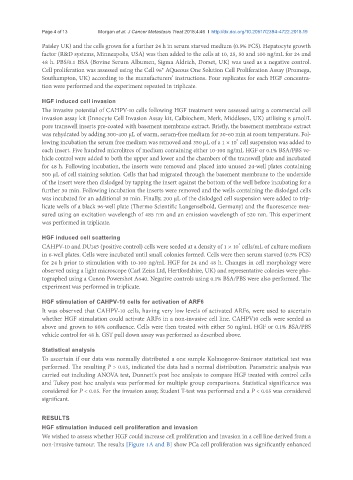Page 548 - Read Online
P. 548
Page 4 of 13 Morgan et al. J Cancer Metastasis Treat 2018;4:46 I http://dx.doi.org/10.20517/2394-4722.2018.19
Paisley UK) and the cells grown for a further 24 h in serum starved medium (0.5% FCS). Hepatocyte growth
factor (R&D systems, Minneapolis, USA) was then added to the cells at 10, 25, 50 and 100 ng/mL for 24 and
48 h. PBS/0.1 BSA (Bovine Serum Albumen, Sigma Aldrich, Dorset, UK) was used as a negative control.
Cell proliferation was assessed using the Cell 96® AQueous One Solution Cell Proliferation Assay (Promega,
Southampton, UK) according to the manufacturers’ instructions. Four replicates for each HGF concentra-
tion were performed and the experiment repeated in triplicate.
HGF induced cell invasion
The invasive potential of CAHPV-10 cells following HGF treatment were assessed using a commercial cell
invasion assay kit (Innocyte Cell Invasion Assay kit, Calbiochem, Merk, Middlesex, UK) utilising 8 µmol/L
pore transwell inserts pre-coated with basement membrane extract. Briefly, the basement membrane extract
was rehydrated by adding 300-400 µL of warm, serum-free medium for 30-60 min at room temperature. Fol-
6
lowing incubation the serum free medium was removed and 350 µL of a 1 × 10 cell suspension was added to
each insert. Five hundred microlitres of medium containing either 10-100 ng/mL HGF or 0.1% BSA/PBS ve-
hicle control were added to both the upper and lower and the chambers of the transwell plate and incubated
for 48 h. Following incubation, the inserts were removed and placed into unused 24-well plates containing
500 µL of cell staining solution. Cells that had migrated through the basement membrane to the underside
of the insert were then dislodged by tapping the insert against the bottom of the well before incubating for a
further 30 min. Following incubation the inserts were removed and the wells containing the dislodged cells
was incubated for an additional 30 min. Finally, 200 µL of the dislodged cell suspension were added to trip-
licate wells of a black 96-well plate (Thermo Scientific Langenselbold, Germany) and the fluorescence mea-
sured using an excitation wavelength of 485 nm and an emission wavelength of 520 nm. This experiment
was performed in triplicate.
HGF induced cell scattering
4
CAHPV-10 and DU145 (positive control) cells were seeded at a density of 1 × 10 cells/mL of culture medium
in 6-well plates. Cells were incubated until small colonies formed. Cells were then serum starved (0.5% FCS)
for 24 h prior to stimulation with 10-100 ng/mL HGF for 24 and 48 h. Changes in cell morphology were
observed using a light microscope (Carl Zeiss Ltd, Hertfordshire, UK) and representative colonies were pho-
tographed using a Canon Powershot A640. Negative controls using 0.1% BSA/PBS were also performed. The
experiment was performed in triplicate.
HGF stimulation of CAHPV-10 cells for activation of ARF6
It was observed that CAHPV-10 cells, having very low levels of activated ARF6, were used to ascertain
whether HGF stimulation could activate ARF6 in a non-invasive cell line. CAHPV10 cells were seeded as
above and grown to 80% confluence. Cells were then treated with either 50 ng/mL HGF or 0.1% BSA/PBS
vehicle control for 48 h. GST pull down assay was performed as described above.
Statistical analysis
To ascertain if our data was normally distributed a one sample Kolmogorov-Smirnov statistical test was
performed. The resulting P > 0.05, indicated the data had a normal distribution. Parametric analysis was
carried out including ANOVA test, Dunnett’s post hoc analysis to compare HGF treated with control cells
and Tukey post hoc analysis was performed for multiple group comparisons. Statistical significance was
considered for P < 0.05. For the invasion assay, Student T-test was performed and a P < 0.05 was considered
significant.
RESULTS
HGF stimulation induced cell proliferation and invasion
We wished to assess whether HGF could increase cell proliferation and invasion in a cell line derived from a
non-invasive tumour. The results [Figure 1A and B] show PCa cell proliferation was significantly enhanced

